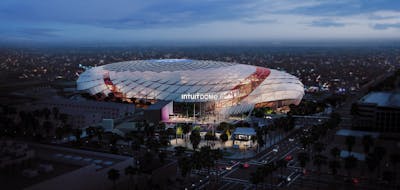
This article by Narendra K. Gosain, originally appeared in the February 2023 issue of Structure Magazine.
Overview
Since the inception of the sports, football and baseball fans have been subjected to a wide range of weather conditions ranging from rain, sleet, and snow to hot and humid weather in an open-air environment to watch their favorite teams compete.
That was until the Houston Astrodome was opened in 1965. Touted as the Eighth Wonder of the World, the Astrodome was a catalyst for today’s modern billion-dollar indoor stadiums that dot the worldwide sports landscape.
The dream of a fully air-conditioned domed stadium was that of Roy M. Hofheinz, a Houston politician who served as Houston’s mayor and a Harris County judge during his career. Together with his business partner Bob Smith, they created the Houston Sports Association with the goal of getting a major league baseball franchise in Houston. The Houston Sports Association needed the help of Harris County voters to approve a public bond to build the Astrodome. To pass the bond, the support of African American voters was critical, so Hofheinz and Smith elicited the help of Quentin Mease, one of Houston’s most respected and influential African Americans. Mease and other African American leaders agreed to campaign for the bond on the condition that the stadium was opened as an integrated facility.
In 1961, Harris County voters approved a general bond issue of $42 million for the construction of the Astrodome. Ground was broken on the project in 1962, and construction formally began on the Astrodome in 1963.
Originally called the Harris County (Texas) Domed Stadium, it served as the home to the Houston Colt .45s (Major League Baseball, now known as the Houston Astros) and the Houston Oilers (National Football League, now known as the Tennessee Titans). It was the first time a stadium was built for baseball and football that was totally enclosed and air-conditioned.
Still standing today but currently unused, the Astrodome’s circular shape has an outer diameter of 710 feet, covers 9.14 acres, and the clear span of the domed roof is 642 feet. The diameter of the playing field is 516 feet, and the maximum height of the roof above the playing field is 213 feet. Original seating capacities for the nine-level multi-purpose stadium ranged from 45,772 for baseball, 52,382 for football, 55,000 for conventions, and 66,000 for boxing. In 1989, 10,000 new seats were added to the facility to increase the capacity for baseball and football games. The stadium was constructed for just over $45 million (1960s dollars), and the structural costs totaled $5.3 million for the stadium and $1.5 million for the domed roof.
The Astrodome is a domed circular concrete and steel-framed building. One of the foremost challenges of the project was the dome roof structure.
The dome roof had to be affordable and aesthetically pleasing. Structurally, the roof also had to withstand hurricane wind speeds and minimize wind sail. The shape and construction of the roof also had to consider heating/cooling demands to minimize air volume. Even still, it required using equipment with approximately 6,000 tons of cooling capacity circulating approximately 2,000,000 cubic feet of air per minute to cool and heat the stadium. The fresh air intake was required to be approximately 200,000 cubic feet per minute, while any smoke or hot air was to be expelled from the top of the dome.
Competitive design proposals were submitted by interested firms with experience and expertise in long-span roof structures. Each firm submitted designs that conformed to the required specifications, which included the following:
- Roof live load 15 psf
- Sonic boom loading 2 psf
- Wind load 40 psf (or load from wind tunnel testing using sustained wind velocity of 135 mph with gusts of 165 mph)
- Dead load: Self-weight of structure
- Superimposed dead load: Three-inch thick Tectum deck on bulb tees with plastic skylights
Unique to the Astrodome was sonic boom loading. In a simple definition, a sonic boom is a manmade thunder caused by shock waves from aircraft flying at speeds faster than sound. Shock waves radiate from the plane in a conical shape exerting pressure. When the lower edge of the pressure cone impinges on the ground, the shock wave is heard as a boom. The speed of sound is 1,125 feet/second or 767 miles per hour.This speed is commonly referred to as Mach 1. After Charles Elwood Yaeger, a United States Air Force officer, broke the sound barrier in 1947 by flying the Bell X-1 aircraft, there was much excitement and discussion about commercial flights flying at speeds greater than sound. The study on supersonic flights started in earnest in 1955. Because the site selected for the Astrodome was only about 8 aerial miles from William P. Hobby Airport, it was considered prudent to consider this sonic boom loading for designing the long-span roof structure of the Astrodome. Indeed, supersonic commercial flights operated in the United States for about 30 years, starting in 1973.


